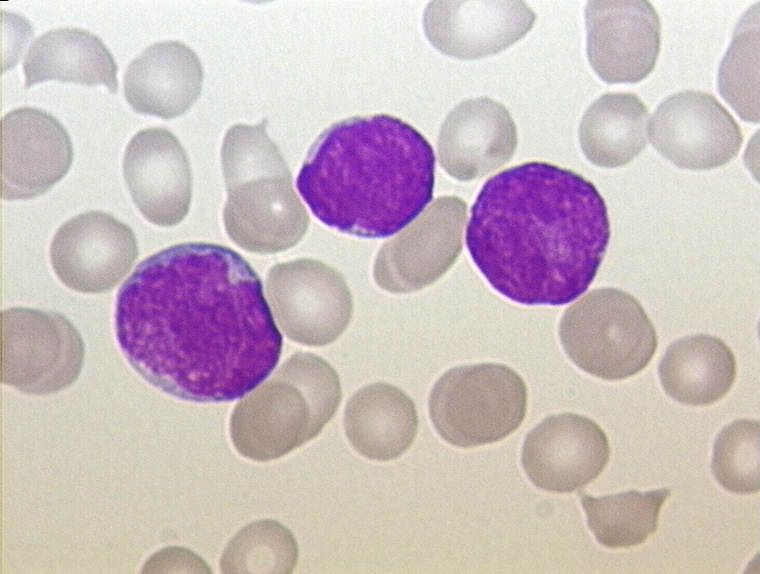Blinatumomab Improves OS/DFS in Low-Risk, Relapsed ALL Subgroup
Combined with chemotherapy, blinatumomab appears tolerable and beneficial in a subgroup of pediatric patients with B-cell acute lymphoblastic leukemia in first relapse but does not yield better survival outcomes in the overall population.
"[The] AALL1331 [trial] establishes that blinatumomab improves DFS and OS for children, adolescents, and young adults with [low-risk first B-cell ALL bone marrow relapse] with or without [extramedullary] disease, defining a new standard of care for these patients," according to the authors of the phase 3 Children’s Oncology Group AALL1331 trial (NCT02101853).

The addition of blinatumomab (Blincyto) to chemotherapy did not improve overall survival (OS) and disease-free survival (DFS) over chemotherapy alone among patients younger than 30 years old with low-risk, B-cell acute lymphoblastic leukemia (ALL) in first relapse; however, the regimen did confer benefit in patients with bone marrow and/or extramedullary relapse, according to novel findings from the phase 3 Children’s Oncology Group AALL1331 trial (NCT02101853) published in Pediatric Oncology.
The rate of DFS at 4 years was 61.2%±5.0% with blinatumomab vs 49.5%±5.2% with chemotherapy (HR, 0.76; 95% CI, 0.51-1.14; P = .089). Moreover, the OS rate at the same timepoint was 90.4%±3.0% vs 79.6%±4.3%, respectively (HR, 0.65; 95% CI, 0.32-1.30; P = .11).
Among patients with bone marrow and/or extramedullary relapse, the 4-year DFS rate was 72.7%±5.8% vs 53.7%±6.7% with blinatumomab vs chemotherapy alone, respectively (HR, 0.53; 95% CI, 0.30-0.95; P = .015), and the 4-year OS rate was 97.1%±2.1% vs 84.8%±4.8% (HR, 0.28; 95% CI, 0.08-1.02; P = .020). Among patients with isolated extramedullary relapse, the corresponding figures for DFS were 36.6%±8.2% vs 38.8%±8.0%, respectively (HR, 1.09; 95% CI, 0.62-1.93; P = .62); the rates for OS were 76.5%±7.5% vs 68.8%±8.6%, respectively (HR, 1.04; 95% CI, 0.43-2.50; P = .53).
The difference between the 2 cohorts was largely driven by second relapses in patients with isolated central nervous system (CNS) relapses, who had 4-year DFS rates of 24.7%±8.9% vs 24.0%±7.9% with blinatumomab vs chemotherapy, respectively (P = .47), and 4-year OS rates of 75.0%±9.1% vs 60.3%±10.3% (P = .34).
The predictors of DFS in patients with isolated extramedullary relapse were the site of first relapse—testes vs CNS (HR, 0.19; 95% CI, 0.04-0.90; P = .017)—and the time between diagnosis to first relapse—over 36 months vs between 18 and 36 months (HR, 0.42; 95% CI, 0.20-0.91; P = .017).
“Among children, adolescents, and young adults with [low-risk] first relapse of [B-cell ALL], treatment with blinatumomab did not result in a statistically significant difference in DFS/OS for the group as a whole,” the investigators wrote. “However, for the two thirds of patients with bone marrow and extramedullary relapse, blinatumomab significantly improved DFS/OS when compared with standard chemotherapy.
“By contrast, similar outcomes and poor DFS for both arms were observed in the one third of patients with isolated extramedullary relapse; new treatment approaches are needed for these patients.”
Investigators enrolled 669 patients on the AALL1331 study between January 2014 and September 2019, of whom 255 were eligible. These patients were randomly assigned 1:1 to either treatment arm.
Demographic characteristics were well-balanced between treatment arms. The median ages at enrollment were 11 (interquartile range [IQR], 7-15) and 10 years (IQR, 7-15) in the blinatumomab and chemotherapy arms, respectively, and the median ages at initial diagnosis were 6 (IQR, 3-9) and 5 (IQR, 2-9) years. Both arms were mostly made up of male patients (59.8% vs 59.4%). White patients comprised 78.4% of the blinatumomab arm and 82.5% of the chemotherapy arm.
The treatment consisted of either standard chemotherapy alone or with intravenous blinatumomab, which was administered at a dose of 15 μg/m2 per day as a continuous infusion for 28 days followed by a 1-week rest period. Patients in the experimental arm also received dexamethasone at a dose of 5 mg/m2 anywhere from 30 to 60 minutes prior to blinatumomab or during their first treatment block after an interruption of at least 4 hours.
The primary end point was DFS, and the secondary end point was OS.
Toxicities of grade 3 or higher were less frequent during the first treatment block of blinatumomab than in the corresponding chemotherapy block. In each respective arm, febrile neutropenia affected 3% vs 48% of patients (P <.001), infections affected 5% vs 51% (P <.001), sepsis affected 0% vs 11% (P <.001), anemia affected 13% vs 58% (P <.001), and mucositis affected 1% vs 7% (P = .018). All blinatumomab-related adverse effects (AEs) were reversible. Of those treated with blinatumomab, 1.6% could not proceed with therapy due to AEs.
“[The] AALL1331 [trial] establishes that blinatumomab improves DFS and OS for children, adolescents, and young adults with [low-risk first B-cell ALL bone marrow relapse] with or without [extramedullary] disease, defining a new standard of care for these patients,” the investigators concluded. “However, low-risk patients with isolated CNS relapse fared poorly with or without blinatumomab, and different treatment strategies for this group are urgently needed.”
Reference
Hogan LE, Brown PA, Ji L, et al. Children's Oncology Group AALL1331: phase III trial of blinatumomab in children, adolescents, and young adults with low-risk B-cell ALL in first relapse. J Clin Oncol. Published online May 31, 2023. doi:10.1200/JCO.22.02200